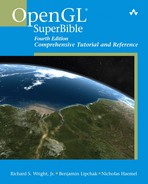Part II. The New Testament
For many years the fixed pipeline reigned supreme as the model for hardware-accelerated 3D graphics. In comparison, the transition to programmable hardware was virtually overnight. In a single generation of consumer graphics hardware, we went from barely configurable texture units and some meager vertex programmability to fully programmable graphics pipelines.
Now, it is possible to dramatically increase realism by writing code that gets executed on the GPU (graphics processing unit). This code can add tremendous flexibility to how vertices and individual fragments onscreen are processed. In addition, these tasks are almost embarrassingly parallel in nature. Multiple execution units designed solely for graphics processing type tasks are getting faster every generation at a rate that far outpaces the increases in regular CPU performance.
Programmable hardware is not the future of graphics hardware, it is the current state of the art. Building on the foundation and concepts of the fixed pipeline, shaders usher in a new era of graphics programming and real-time visual effects. Much of the last part of the book is still vital to using OpenGL. For example, we must still load and bind textures, we must still modify and maintain our matrix stacks, and we must still submit batches of vertex data. As you’ll soon discover in the following chapters, however, there is a whole lot that can be done after your application turns loose of those vertices!
